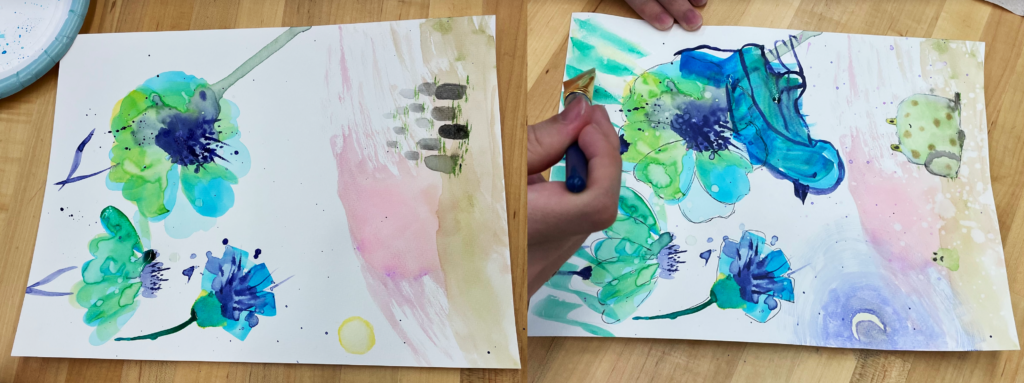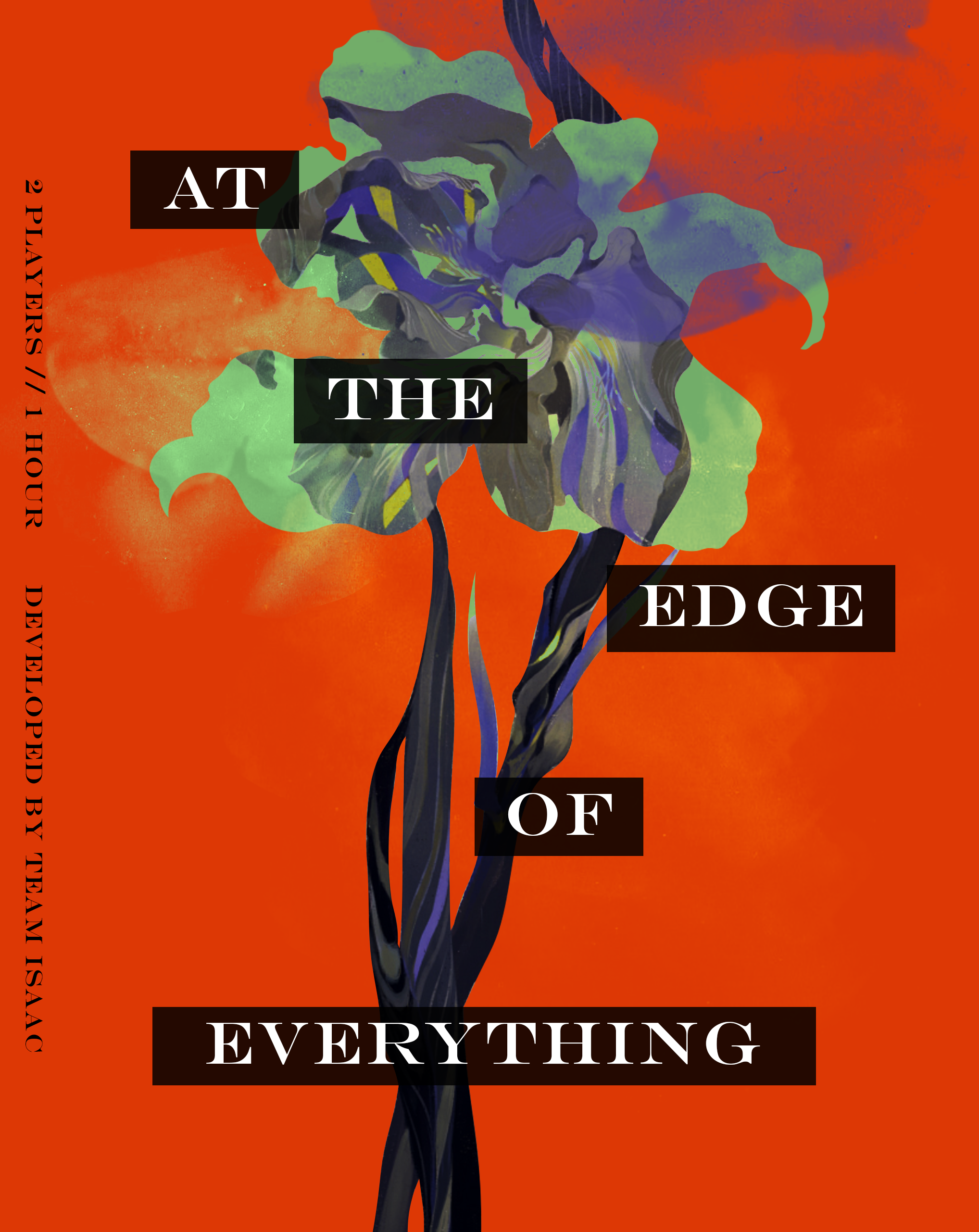Team Isaac: Evis Bleta, Izzy Martino, JJ Abu-Halimah, Eren Slifker, and Noor Amin
Overview
At the Edge of Everything is a two-player game about how memories shape one’s identity and relationships. Our game progresses over three phases—an individual memory, a memory of the other player, and a shared memory—emphasizing mutual character discovery through a collaborative watercolor painting.
Both players face each other on opposite sides of watercolor paper at the start of the game. In lieu of a character sheet, the player is prompted to depict a personal memory on their side of the painting. They take turns describing their memory, while the other player remains silent. If the player feels stuck in the process of describing the memory, they may draw an Affect card, which hints at a feeling or reaction to help jog their memory of the event. After both players share their memory, they partially lift the paint from the paper using water, leaving behind a faded afterimage of their painted memory.
At the start of the second phase, the players rotate the paper, such that their partner’s previous painting now acts as their canvas. They subsequently take turns describing a memory of the other player, incorporating the previous painting’s hues into their depiction.
The last phase centers around a shared memory, in which the two players similarly take turns describing a memory involving each other. Rather than speaking separately, the players are invited to converse for the first time.
At the Edge of Everything aims to evoke a meditative experience that foregrounds transient moments of intimacy and reflection through largely non-verbal modes of communication. At a high level, it explores the boundaries between one’s inner child and old age, memory creation and decay, and ritual and discovery.
Process and Experimentation
Our design process began through a whole-team brainstorming session, in which we discussed the core pillars of our game. Firstly, we communicated that we preferred to approach the game through the lens of affective contributions rather than specific mechanics, with the intention of exploring the emotional capacity of different gameplay elements. Secondarily, we aligned on creating a game without a GM, given that most of our team members were relatively new to TTRPGs and wanted to produce a game accessible to individuals without prior experience within the genre. Hence, At the Edge of Everything mimics the rules-light, “no dice, no masters” structure of Dream Askew (2018). Lastly, we expressed our interest in shifting away from the emotional palette of many of the games we referenced—namely Cthulhu Dark (2010) and Ten Candles (2015)—which leveraged tragedy to produce localized climactic moments. Conversely, we sought to create a slower and more meditative experience. Eren and Izzy proposed forgetting, specifically in the context of dementia, as an emotionally heavy but not cataclysmic narrative grounding. From that concept, Noor offered watercolor as a motif to concretize the behavior in memories and mirror the more distributed, amorphous emotional architecture of the game.
Our first prototype framed both players as individuals suffering from dementia. Specifically, that incarnation concerned the experience of rebuilding memories from fragments. One player verbalized a specific memory, and their partner rolled a die to determine how well they could recall that memory. The value of the die dictated how much time the pair had to paint the memory. Each time the players encountered a traumatic memory, the amount of time they had to paint decreased, creating a sense of running out of time near the end of life. Because of the heaviness of this subject matter, care was taken to ensure that we did not enforce a particular relationship (romantic, familial, or otherwise) onto the characters. Rather, we allowed the players to situate themselves in the ambiguity of their partnership and define a history comfortable for them.
Iteration and Challenges
Prior to our second group meeting, Eren, Noor, and Izzy created a collaborative, evolving watercolor piece together. Though the painting occurred outside of the context of our gameplay experience, it revealed the “inner child” aspect of its core mechanic, marking a tonal shift away from progressive devastation. The iteration of the game we will share with the class will be even more nebulous in affect but more formal in its temporal structure. Specifically, At the Edge of Everything currently focuses not on dementia but rather memories more broadly—for instance, in the context of recounting one’s life near death. The role-playing element remains centered around human actors, and the slowness of pacing is conducive to older characters, though we do not explicitly enforce either element in the ruleset.

Our primary obstacle in this project has been the balance between structure and interpretive openness. At the Edge of Everything borrows recognizable TTRPG elements but poses a significant departure in their implementation; chance emerges from drawing memories and affects from decks, improvisation arises from both painting and conversation-based resolution mechanics, and the game has a discrete character creation phase. To further distinguish our game from playing pretend, we have been exploring rituals—such as specific invocation phrases when narrating—to add structure to the improvisational elements and encourage role-play.
Schedule and Accomplishments
At the midpoint of our design process, we’ve solidified our core gameplay mechanics and tonal bar, in addition to exploring visual design elements. Moreover, our initial painting session allowed us to solidify the timing of each phase.
Moving forward, we plan on maintaining a cadence of meeting twice per week as a group in-person and communicating asynchronously through our Discord server. We aim to divide up the remainder of the work for the card contents, documentation, and art after we receive feedback on our prototype.

